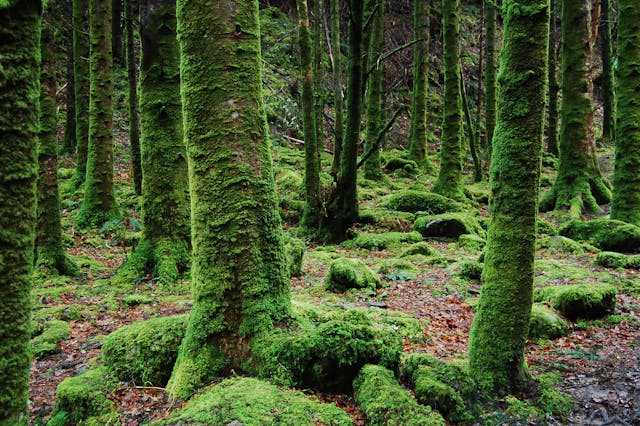
Is moss one plant or many plants? A patch of moss is made up of many plants.
There are many types. There are approximately 20,000 species of moss plants and some of them are huge. The Dawsonia moss grows up to 50 cm tall. However, most moss plants are much smaller than that. Mosses have been around for millions of years, and they can grow anywhere there is moisture and is a little shaded.
When you see moss, it is usually on a rock, a tree trunk, or on the ground. It looks like a carpet sometimes and it appears to be one plant, but it is actually a patch of many tiny plants. Each one is only a few millimeters to a cm tall. They are plants, but they do not share all the characteristics of other plants. They make their energy through photosynthesis, but they don’t have a vascular system. The vascular system is the network of cells that carry water, nutrients, and sugars from their roots to their leaves and back again. Many mosses don’t have this. Mosses also don’t usually have roots. Their stems are also very small and not very strong. That is a generalization because some mosses do have a vascular system and the Dawsonia moss has a strong stem, but most don’t.
If mosses don’t have roots, how do they anchor themselves and get nutrients and water? They anchor themselves using tiny hairs called rhizoids. These are very short, thin filaments that many plants, such as sponges and fungi, use to attach themselves to surfaces. They give the moss stability, but they cannot absorb any water or nutrients. They absorb water and nutrients directly through their leaves. Their leaves are usually made of a single cell and they can absorb water by osmosis. They are highly absorbent. If moss dries out because of a drought, they can rehydrate in seconds if it rains and start photosynthesizing almost straight away.
This is the reason why mosses usually grow in shaded and moist regions. They need a constant source of water in the air to absorb. They also need sunlight to photosynthesize, but they don’t want a lot of sunlight because they dry out very easily. They are so thin that they dry out just as quickly as they can absorb water. However, mosses are actually able to survive being completely dried out for quite a long time and it doesn’t kill them. Without water and sunlight, though, they cannot grow.
Mosses are plants, but they don’t produce flowers or pollen. They reproduce through spores, in the same way fungi do. Spores are basically single celled seeds that the plants produce and release. The spores are inside a brown capsule that slowly dries out. When it is completely dried out, it pops open and the spores are carried away by the wind. If they land somewhere with enough moisture, they start to grow.
Moss might be small, but it is a hugely important part of the ecosystem. They live close to the ground, and they cycle nutrients through the soil. They also provide structure and prevent erosion. They reduce the number of bacteria and viruses that get into the soil, protecting other plants. They can keep the temperature of the soil more consistent, acting like a blanket and they can keep moisture from evaporating out of the soil. Mosses settle the soil down and they are usually the first things to grow on the soil of urban areas that have been left to go wild again. They make the soil ready for other plants to grow. Decaying moss is also a source of nutrients for other plants and decaying moss is what makes peat. Mosses are also an enormous sink of CO2. They absorb 6.43 billion tons of carbon dioxide, which is the same at that released by 2.68 billion cars.
People have used moss in many ways for a long time. If it is allowed to grow on the outside of the house, it can be an insulator and keep water away from the walls. It has been used as a sustainable packing alternative and it is highly absorbent, so it has been used as sponges or first-aid dressings. It can absorb over 20 times its own weight. And this is what I learned today.
Photo by Daniel B: https://www.pexels.com/photo/photo-of-trees-covered-in-moss-141233/
Sources
https://kids.mongabay.com/moss-is-the-boss-what-is-moss-and-why-should-people-care-about-it/
https://allabout-moss.com/what-is-moss/
https://en.wikipedia.org/wiki/Moss
https://en.wikipedia.org/wiki/Dawsonia_(plant)
https://www.kew.org/read-and-watch/moss
https://www.seacoastonline.com/story/lifestyle/2013/10/16/moss-will-grow-anywhere-it/42529534007/
https://www.britannica.com/science/rhizoid
https://www.nps.gov/arch/learn/nature/mossesandliverworts.htm
